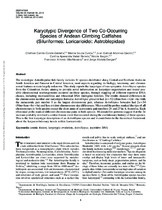| dc.creator | Conde-Saldaña, Cristhian Camilo | |
| dc.creator | Souza Cunha, Marina | |
| dc.creator | Cynthia Aparecida, Valiati Barreto | |
| dc.creator | Villa-Navarro, Franciscco A. | |
| dc.creator | Albornoz Garzon, Juan Gabriel | |
| dc.creator | Ibagón, Nicole | |
| dc.creator | Abdala Dergam, Jorge | |
| dc.date.accessioned | 2019-03-09T15:34:35Z | |
| dc.date.available | 2019-03-09T15:34:35Z | |
| dc.date.issued | 2019-01-31 | |
| dc.identifier.issn | 1557-8542 | spa |
| dc.identifier.uri | http://www.liebertonline.com/zeb | spa |
| dc.identifier.uri | http://hdl.handle.net/20.500.11761/35234 | |
| dc.description | The monotypic Astroblepidae fish family includes 81 species distributed along Central and Northern Andes in South America and Panamá in Central America; most aspects regarding its biology, taxonomy, and chromosomal features remain largely unknown. This study reports the karyotype of two sympatric Astroblepus species from the Colombian Andes, aiming to provide novel information on karyotype organization and reveal possible chromosomal rearrangements occurred on these species, through mapping of different repetitive DNA classes, including microsatellites and ribosomal DNA multigene families. The results showed differences in the chromosome number and karyotypic formula: Astroblepus grixalvii had 2n = 52 (28m+8sm +12st +4a) with the metacentric pair number 1 as the largest chromosome pair, whereas Astroblepus homodon had 2n = 54 (30m+8sm +8st +8a) and less evident chromosome size differences. Microsatellite probes marked the tips of all chromosomes in both species except the short arms of acrocentric pair numbers 24 and 25 in A. homodon. Each ribosomal probe marked different chromosome pairs in both species. Microsatellite patterns suggest that the 2n increase probably involved a centric fission event that occurred during the evolutionary history of these species. This is the first karyotype description of an Astroblepus species and it contributes to the theoretical framework about the karyoevolutionary trends within Loricarioidei. | spa |
| dc.description.abstract | La familia de peces monotípicos Astroblepidae incluye 81 especies distribuidas a lo largo de los Andes centrales y septentrionales en América del Sur y Panamá en América Central; la mayoría de los aspectos relacionados con su biología, taxonomía y características cromosómicas siguen siendo en gran parte desconocidos. Este estudio informa sobre el cariotipo de dos especies simpátricas de Astroblepus de los Andes colombianos, con el objetivo de proporcionar información novedosa sobre la organización del cariotipo y revelar posibles reordenamientos cromosómicos ocurridos en estas especies, a través del mapeo de diferentes clases repetitivas de ADN, incluyendo microsatélites y familias multigénicas de ADN ribosomal. Los resultados mostraron diferencias en el número de cromosomas y la fórmula cariotípica: Astroblepus grixalvii tuvo 2 n = 52 (28m + 8sm + 12st + 4a) con el par metacéntrico número 1 como el par de cromosomas más grande, mientras que Astroblepus homodon tenía 2 n = 54 (30m + 8sm + 8st + 8a) y menos evidentes diferencias en el tamaño de los cromosomas. Las sondas de microsatélite marcaron las puntas de todos los cromosomas en ambas especies, excepto los brazos cortos de los pares acrocéntricos números 24 y 25 en A. homodon . Cada sonda ribosomal marcó diferentes pares de cromosomas en ambas especies. Los patrones de microsatélite sugieren | spa |
| dc.format | application/pdf | spa |
| dc.format.extent | 9 | spa |
| dc.language.iso | spa | spa |
| dc.relation.ispartofseries | 16(1) | spa |
| dc.relation.uri | https://www.liebertpub.com/doi/10.1089/zeb.2018.1659 | spa |
| dc.rights | Attribution-NonCommercial-NoDerivatives 4.0 International | * |
| dc.rights.uri | http://creativecommons.org/licenses/by-nc-nd/4.0/ | * |
| dc.source | reponame: Repositorio Institucional de Documentación Científica Humboldt | spa |
| dc.source | instname: Instituto de Investigación de Recursos Biológicos Alexander von Humboldt | spa |
| dc.title | Karyotypic Divergence of Two Co-Occurring Species of Andean Climbing Catfishes (Siluriformes: Loricarioidei: Astroblepidae) | spa |
| dc.type | info:eu-repo/semantics/article | spa |
| dc.type.spa | Artículo | spa |
| dc.identifier.doi | https://doi.org/10.1089/zeb.2018.1659 | spa |
| dc.publisher.edition | Regular | spa |
| dc.subject.subjectenglish | Centric | spa |
| dc.subject.subjectenglish | Fission | spa |
| dc.subject.subjectenglish | karyotypic evolution | spa |
| dc.subject.subjectenglish | Astroblepus | spa |
| dc.subject.subjectenglish | Repetitive DNA | spa |
| dc.publisher.journal | Zebrafish | spa |




